LLM2Vec: Large Language Models Are Secretly Powerful Text Encoders

Large decoder-only language models (LLMs) are the state-of-the-art models on most of today's NLP tasks and benchmarks. Yet, the community is only slowly adopting these models for text embedding tasks, which require rich contextualized representations. In this work, we introduce LLM2Vec, a simple unsupervised approach that can transform any decoder-only LLM into a strong text encoder. LLM2Vec consists of three simple steps: 1) enabling bidirectional attention, 2) masked next token prediction, and 3) unsupervised contrastive learning. We demonstrate the effectiveness of LLM2Vec by applying it to 3 popular LLMs ranging from 1.3B to 7B parameters and evaluate the transformed models on English word- and sequence-level tasks. We outperform encoder-only models by a large margin on word-level tasks and reach a new unsupervised state-of-the-art performance on the Massive Text Embeddings Benchmark (MTEB). Moreover, when combining LLM2Vec with supervised contrastive learning, we achieve state-of-the-art performance on MTEB among models that train only on publicly available data. Our strong empirical results and extensive analysis demonstrate that LLMs can be effectively transformed into universal text encoders in a parameter-efficient manner without the need for expensive adaptation or synthetic GPT-4 generated data.
InternLM-XComposer2-4KHD: A Pioneering Large Vision-Language Model Handling Resolutions from 336 Pixels to 4K HD
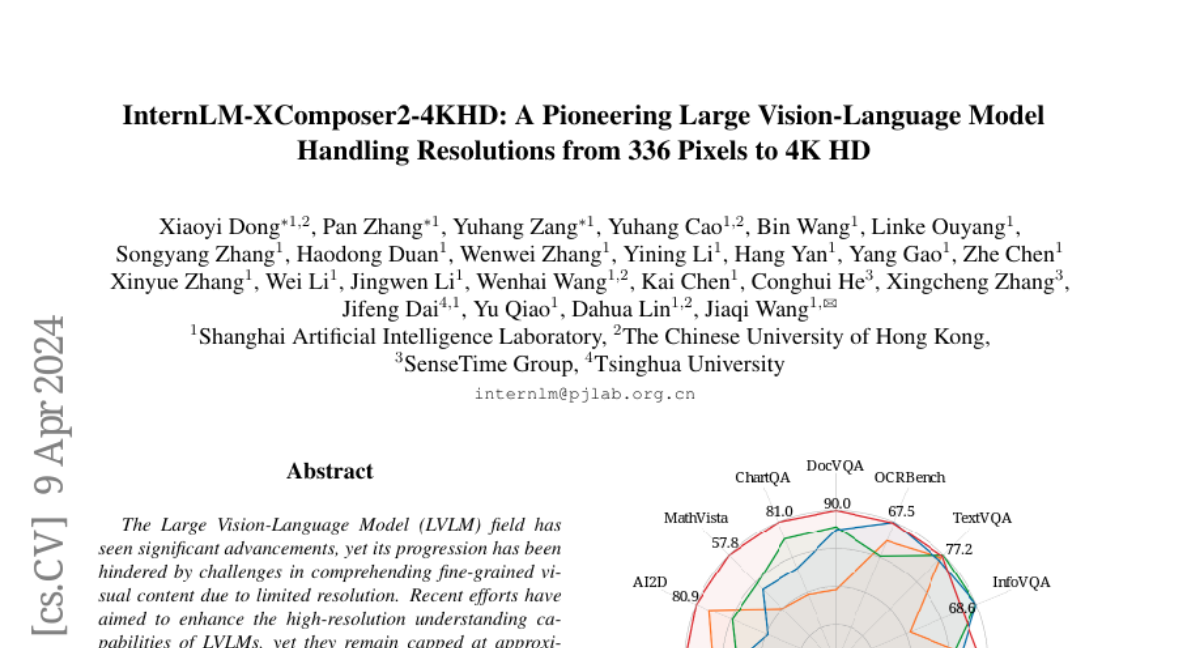
The Large Vision-Language Model (LVLM) field has seen significant advancements, yet its progression has been hindered by challenges in comprehending fine-grained visual content due to limited resolution. Recent efforts have aimed to enhance the high-resolution understanding capabilities of LVLMs, yet they remain capped at approximately 1500 x 1500 pixels and constrained to a relatively narrow resolution range. This paper represents InternLM-XComposer2-4KHD, a groundbreaking exploration into elevating LVLM resolution capabilities up to 4K HD (3840 x 1600) and beyond. Concurrently, considering the ultra-high resolution may not be necessary in all scenarios, it supports a wide range of diverse resolutions from 336 pixels to 4K standard, significantly broadening its scope of applicability. Specifically, this research advances the patch division paradigm by introducing a novel extension: dynamic resolution with automatic patch configuration. It maintains the training image aspect ratios while automatically varying patch counts and configuring layouts based on a pre-trained Vision Transformer (ViT) (336 x 336), leading to dynamic training resolution from 336 pixels to 4K standard. Our research demonstrates that scaling training resolution up to 4K HD leads to consistent performance enhancements without hitting the ceiling of potential improvements. InternLM-XComposer2-4KHD shows superb capability that matches or even surpasses GPT-4V and Gemini Pro in 10 of the 16 benchmarks. The InternLM-XComposer2-4KHD model series with 7B parameters are publicly available at https://github.com/InternLM/InternLM-XComposer.
Eagle and Finch: RWKV with Matrix-Valued States and Dynamic Recurrence
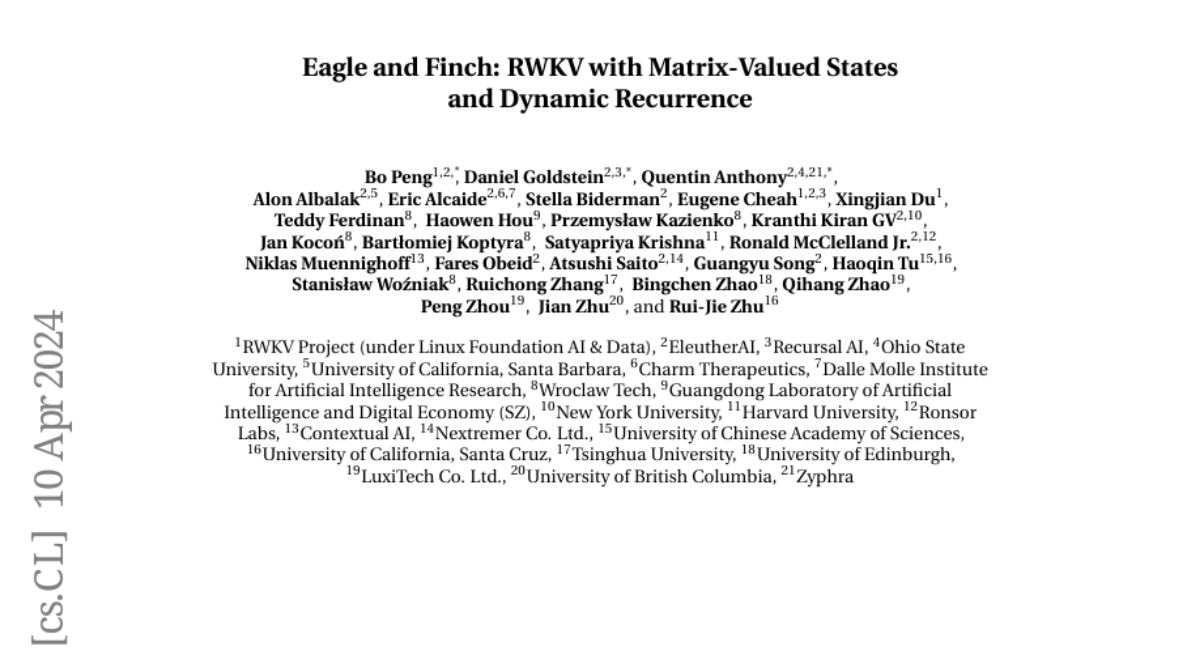
We present Eagle (RWKV-5) and Finch (RWKV-6), sequence models improving upon the RWKV (RWKV-4) architecture. Our architectural design advancements include multi-headed matrix-valued states and a dynamic recurrence mechanism that improve expressivity while maintaining the inference efficiency characteristics of RNNs. We introduce a new multilingual corpus with 1.12 trillion tokens and a fast tokenizer based on greedy matching for enhanced multilinguality. We trained four Eagle models, ranging from 0.46 to 7.5 billion parameters, and two Finch models with 1.6 and 3.1 billion parameters and find that they achieve competitive performance across a wide variety of benchmarks. We release all our models on HuggingFace under the Apache 2.0 license. Models at: https://huggingface.co/RWKV Training code at: https://github.com/RWKV/RWKV-LM Inference code at: https://github.com/RWKV/ChatRWKV Time-parallel training code at: https://github.com/RWKV/RWKV-infctx-trainer
Hash3D: Training-free Acceleration for 3D Generation
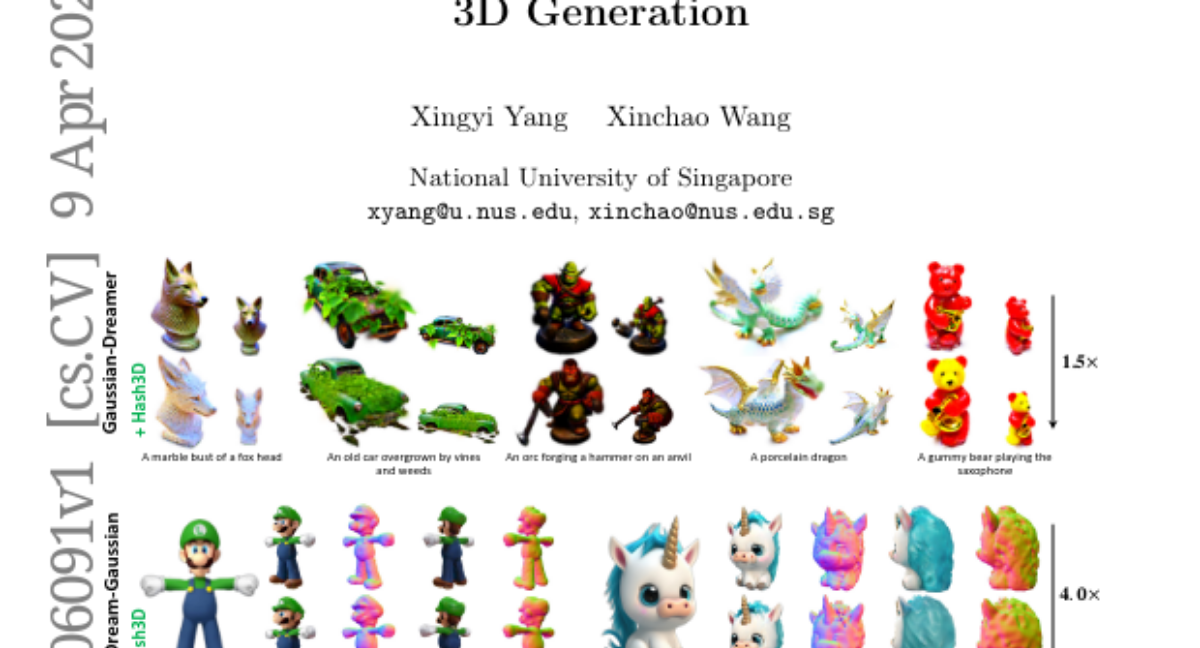
The evolution of 3D generative modeling has been notably propelled by the adoption of 2D diffusion models. Despite this progress, the cumbersome optimization process per se presents a critical hurdle to efficiency. In this paper, we introduce Hash3D, a universal acceleration for 3D generation without model training. Central to Hash3D is the insight that feature-map redundancy is prevalent in images rendered from camera positions and diffusion time-steps in close proximity. By effectively hashing and reusing these feature maps across neighboring timesteps and camera angles, Hash3D substantially prevents redundant calculations, thus accelerating the diffusion model's inference in 3D generation tasks. We achieve this through an adaptive grid-based hashing. Surprisingly, this feature-sharing mechanism not only speed up the generation but also enhances the smoothness and view consistency of the synthesized 3D objects. Our experiments covering 5 text-to-3D and 3 image-to-3D models, demonstrate Hash3D's versatility to speed up optimization, enhancing efficiency by 1.3 to 4 times. Additionally, Hash3D's integration with 3D Gaussian splatting largely speeds up 3D model creation, reducing text-to-3D processing to about 10 minutes and image-to-3D conversion to roughly 30 seconds. The project page is at https://adamdad.github.io/hash3D/.
OmniFusion Technical Report
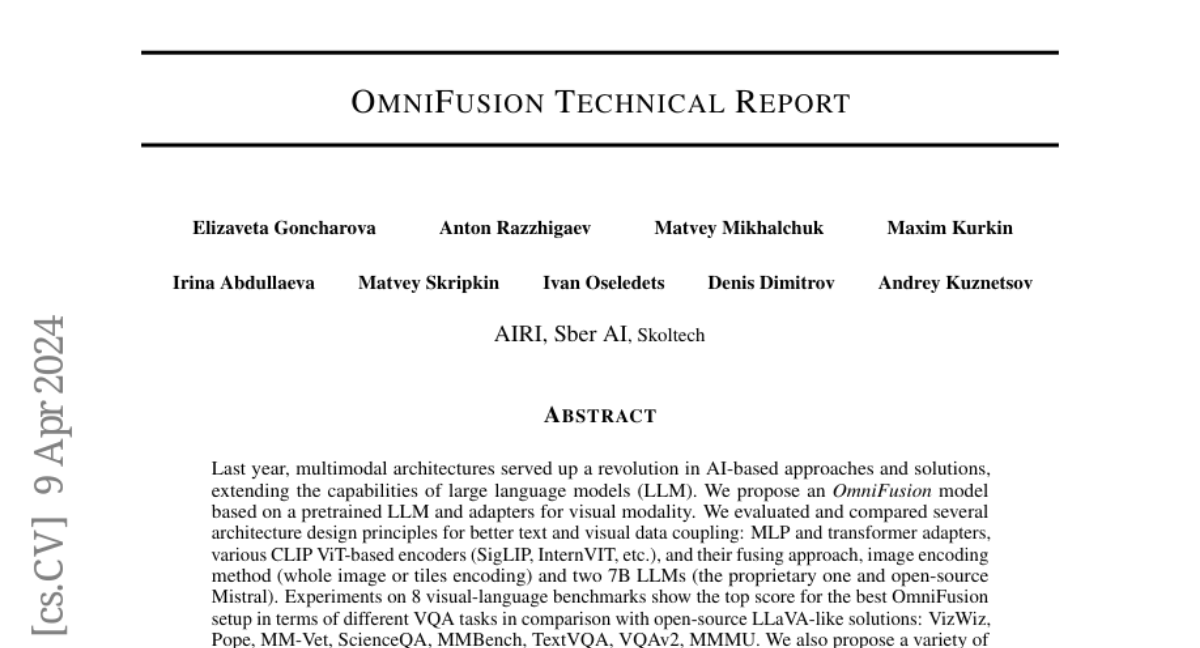
Last year, multimodal architectures served up a revolution in AI-based approaches and solutions, extending the capabilities of large language models (LLM). We propose an \textit{OmniFusion} model based on a pretrained LLM and adapters for visual modality. We evaluated and compared several architecture design principles for better text and visual data coupling: MLP and transformer adapters, various CLIP ViT-based encoders (SigLIP, InternVIT, etc.), and their fusing approach, image encoding method (whole image or tiles encoding) and two 7B LLMs (the proprietary one and open-source Mistral). Experiments on 8 visual-language benchmarks show the top score for the best OmniFusion setup in terms of different VQA tasks in comparison with open-source LLaVA-like solutions: VizWiz, Pope, MM-Vet, ScienceQA, MMBench, TextVQA, VQAv2, MMMU. We also propose a variety of situations, where OmniFusion provides highly-detailed answers in different domains: housekeeping, sightseeing, culture, medicine, handwritten and scanned equations recognition, etc. Mistral-based OmniFusion model is an open-source solution with weights, training and inference scripts available at https://github.com/AIRI-Institute/OmniFusion.
SambaLingo: Teaching Large Language Models New Languages
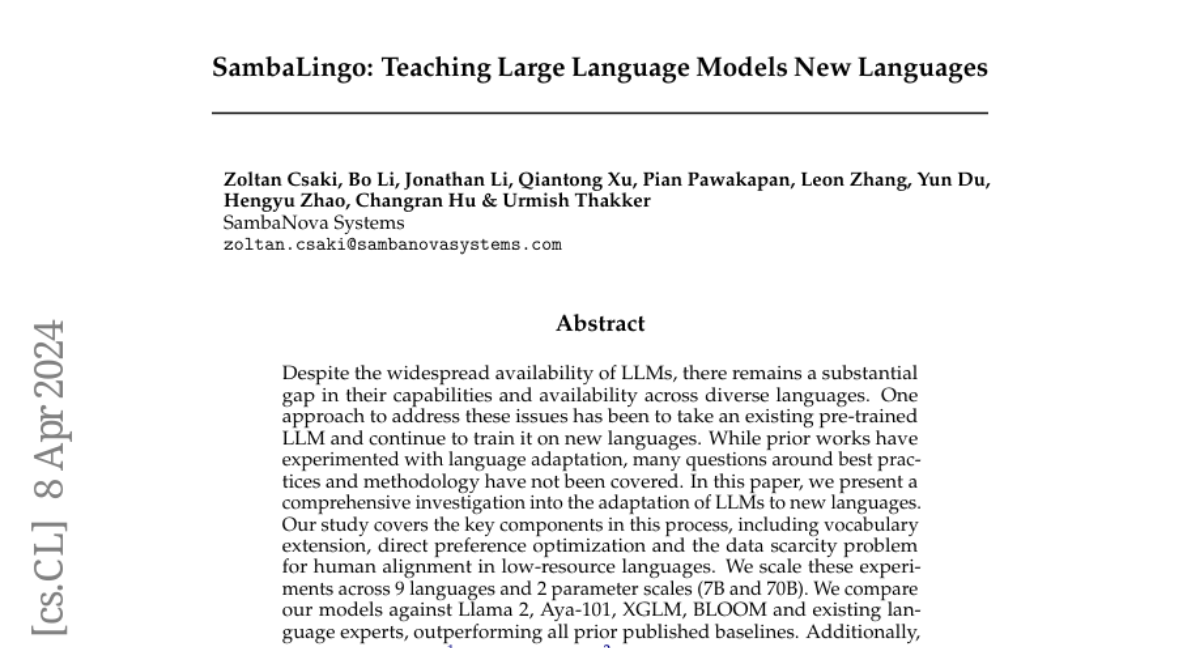
Despite the widespread availability of LLMs, there remains a substantial gap in their capabilities and availability across diverse languages. One approach to address these issues has been to take an existing pre-trained LLM and continue to train it on new languages. While prior works have experimented with language adaptation, many questions around best practices and methodology have not been covered. In this paper, we present a comprehensive investigation into the adaptation of LLMs to new languages. Our study covers the key components in this process, including vocabulary extension, direct preference optimization and the data scarcity problem for human alignment in low-resource languages. We scale these experiments across 9 languages and 2 parameter scales (7B and 70B). We compare our models against Llama 2, Aya-101, XGLM, BLOOM and existing language experts, outperforming all prior published baselines. Additionally, all evaluation code and checkpoints are made public to facilitate future research.
MuPT: A Generative Symbolic Music Pretrained Transformer

In this paper, we explore the application of Large Language Models (LLMs) to the pre-training of music. While the prevalent use of MIDI in music modeling is well-established, our findings suggest that LLMs are inherently more compatible with ABC Notation, which aligns more closely with their design and strengths, thereby enhancing the model's performance in musical composition. To address the challenges associated with misaligned measures from different tracks during generation, we propose the development of a \underline{S}ynchronized \underline{M}ulti-\underline{T}rack ABC Notation (\textbf{SMT-ABC Notation}), which aims to preserve coherence across multiple musical tracks. Our contributions include a series of models capable of handling up to 8192 tokens, covering 90\% of the symbolic music data in our training set. Furthermore, we explore the implications of the \underline{S}ymbolic \underline{M}usic \underline{S}caling Law (\textbf{SMS Law}) on model performance. The results indicate a promising direction for future research in music generation, offering extensive resources for community-led research through our open-source contributions.
Magic-Boost: Boost 3D Generation with Mutli-View Conditioned Diffusion
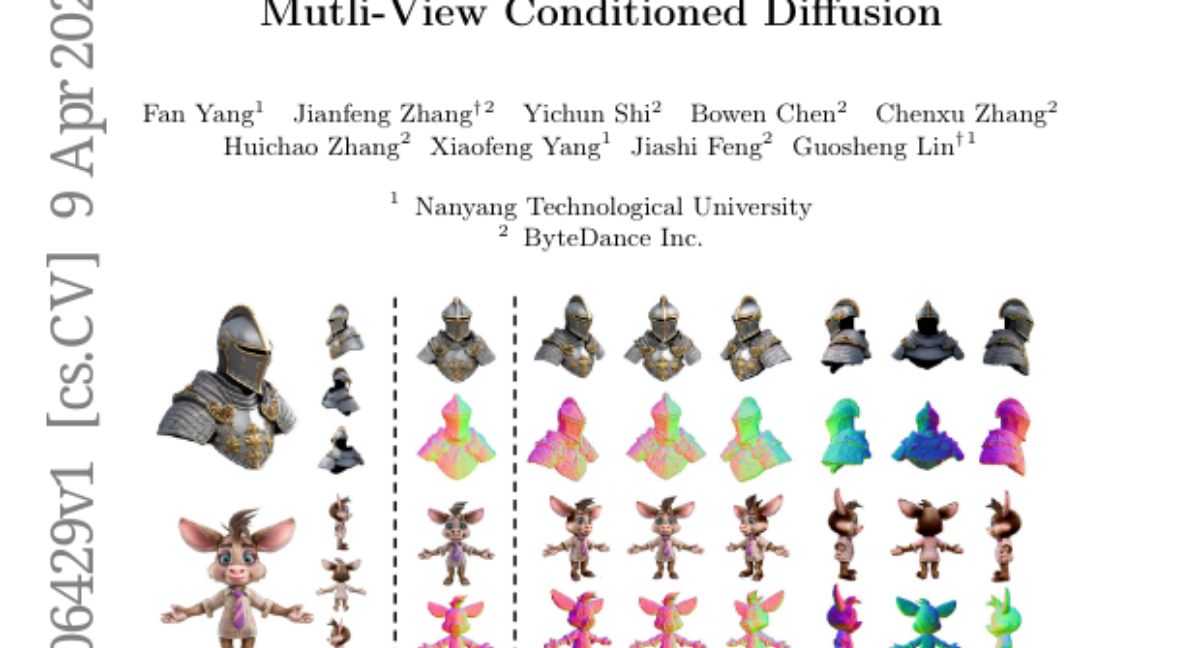
Benefiting from the rapid development of 2D diffusion models, 3D content creation has made significant progress recently. One promising solution involves the fine-tuning of pre-trained 2D diffusion models to harness their capacity for producing multi-view images, which are then lifted into accurate 3D models via methods like fast-NeRFs or large reconstruction models. However, as inconsistency still exists and limited generated resolution, the generation results of such methods still lack intricate textures and complex geometries. To solve this problem, we propose Magic-Boost, a multi-view conditioned diffusion model that significantly refines coarse generative results through a brief period of SDS optimization ($\sim15$min). Compared to the previous text or single image based diffusion models, Magic-Boost exhibits a robust capability to generate images with high consistency from pseudo synthesized multi-view images. It provides precise SDS guidance that well aligns with the identity of the input images, enriching the local detail in both geometry and texture of the initial generative results. Extensive experiments show Magic-Boost greatly enhances the coarse inputs and generates high-quality 3D assets with rich geometric and textural details. (Project Page: https://magic-research.github.io/magic-boost/)
Revising Densification in Gaussian Splatting

In this paper, we address the limitations of Adaptive Density Control (ADC) in 3D Gaussian Splatting (3DGS), a scene representation method achieving high-quality, photorealistic results for novel view synthesis. ADC has been introduced for automatic 3D point primitive management, controlling densification and pruning, however, with certain limitations in the densification logic. Our main contribution is a more principled, pixel-error driven formulation for density control in 3DGS, leveraging an auxiliary, per-pixel error function as the criterion for densification. We further introduce a mechanism to control the total number of primitives generated per scene and correct a bias in the current opacity handling strategy of ADC during cloning operations. Our approach leads to consistent quality improvements across a variety of benchmark scenes, without sacrificing the method's efficiency.
Elephants Never Forget: Memorization and Learning of Tabular Data in Large Language Models

While many have shown how Large Language Models (LLMs) can be applied to a diverse set of tasks, the critical issues of data contamination and memorization are often glossed over. In this work, we address this concern for tabular data. Specifically, we introduce a variety of different techniques to assess whether a language model has seen a tabular dataset during training. This investigation reveals that LLMs have memorized many popular tabular datasets verbatim. We then compare the few-shot learning performance of LLMs on datasets that were seen during training to the performance on datasets released after training. We find that LLMs perform better on datasets seen during training, indicating that memorization leads to overfitting. At the same time, LLMs show non-trivial performance on novel datasets and are surprisingly robust to data transformations. We then investigate the in-context statistical learning abilities of LLMs. Without fine-tuning, we find them to be limited. This suggests that much of the few-shot performance on novel datasets is due to the LLM's world knowledge. Overall, our results highlight the importance of testing whether an LLM has seen an evaluation dataset during pre-training. We make the exposure tests we developed available as the tabmemcheck Python package at https://github.com/interpretml/LLM-Tabular-Memorization-Checker
CodecLM: Aligning Language Models with Tailored Synthetic Data
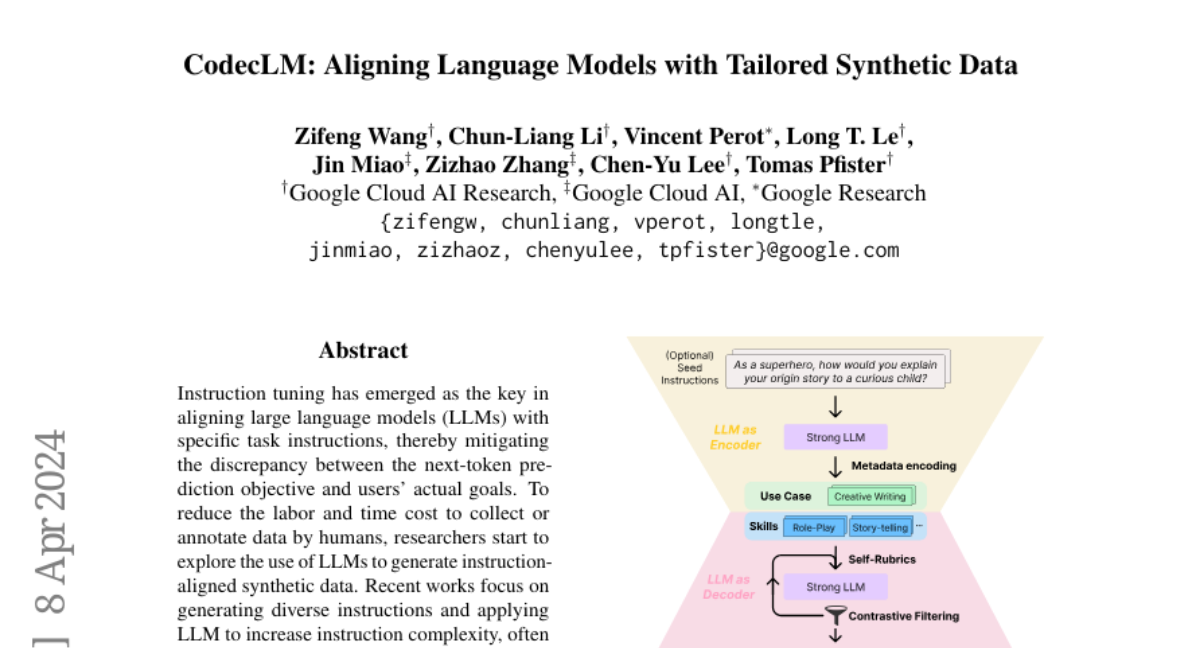
Instruction tuning has emerged as the key in aligning large language models (LLMs) with specific task instructions, thereby mitigating the discrepancy between the next-token prediction objective and users' actual goals. To reduce the labor and time cost to collect or annotate data by humans, researchers start to explore the use of LLMs to generate instruction-aligned synthetic data. Recent works focus on generating diverse instructions and applying LLM to increase instruction complexity, often neglecting downstream use cases. It remains unclear how to tailor high-quality data to elicit better instruction-following abilities in different target instruction distributions and LLMs. To this end, we introduce CodecLM, a general framework for adaptively generating high-quality synthetic data for LLM alignment with different downstream instruction distributions and LLMs. Drawing on the Encode-Decode principles, we use LLMs as codecs to guide the data generation process. We first encode seed instructions into metadata, which are concise keywords generated on-the-fly to capture the target instruction distribution, and then decode metadata to create tailored instructions. We also introduce Self-Rubrics and Contrastive Filtering during decoding to tailor data-efficient samples. Extensive experiments on four open-domain instruction following benchmarks validate the effectiveness of CodecLM over the current state-of-the-arts.
Reconstructing Hand-Held Objects in 3D

Objects manipulated by the hand (i.e., manipulanda) are particularly challenging to reconstruct from in-the-wild RGB images or videos. Not only does the hand occlude much of the object, but also the object is often only visible in a small number of image pixels. At the same time, two strong anchors emerge in this setting: (1) estimated 3D hands help disambiguate the location and scale of the object, and (2) the set of manipulanda is small relative to all possible objects. With these insights in mind, we present a scalable paradigm for handheld object reconstruction that builds on recent breakthroughs in large language/vision models and 3D object datasets. Our model, MCC-Hand-Object (MCC-HO), jointly reconstructs hand and object geometry given a single RGB image and inferred 3D hand as inputs. Subsequently, we use GPT-4(V) to retrieve a 3D object model that matches the object in the image and rigidly align the model to the network-inferred geometry; we call this alignment Retrieval-Augmented Reconstruction (RAR). Experiments demonstrate that MCC-HO achieves state-of-the-art performance on lab and Internet datasets, and we show how RAR can be used to automatically obtain 3D labels for in-the-wild images of hand-object interactions.
MiniCPM: Unveiling the Potential of Small Language Models with Scalable Training Strategies

The burgeoning interest in developing Large Language Models (LLMs) with up to trillion parameters has been met with concerns regarding resource efficiency and practical expense, particularly given the immense cost of experimentation. This scenario underscores the importance of exploring the potential of Small Language Models (SLMs) as a resource-efficient alternative. In this context, we introduce MiniCPM, specifically the 1.2B and 2.4B non-embedding parameter variants, not only excel in their respective categories but also demonstrate capabilities on par with 7B-13B LLMs. While focusing on SLMs, our approach exhibits scalability in both model and data dimensions for future LLM research. Regarding model scaling, we employ extensive model wind tunnel experiments for stable and optimal scaling. For data scaling, we introduce a Warmup-Stable-Decay (WSD) learning rate scheduler (LRS), conducive to continuous training and domain adaptation. We present an in-depth analysis of the intriguing training dynamics that occurred in the WSD LRS. With WSD LRS, we are now able to efficiently study data-model scaling law without extensive retraining experiments on both axes of model and data, from which we derive the much higher compute optimal data-model ratio than Chinchilla Optimal. Additionally, we introduce MiniCPM family, including MiniCPM-DPO, MiniCPM-MoE and MiniCPM-128K, whose excellent performance further cementing MiniCPM's foundation in diverse SLM applications. MiniCPM models are available publicly at https://github.com/OpenBMB/MiniCPM .